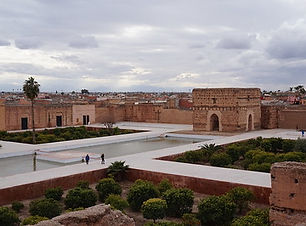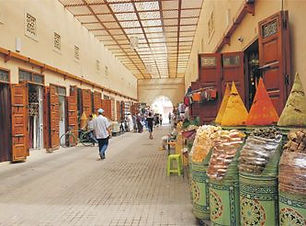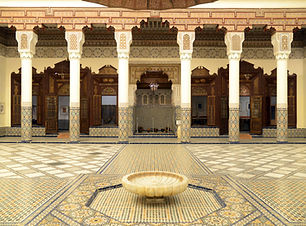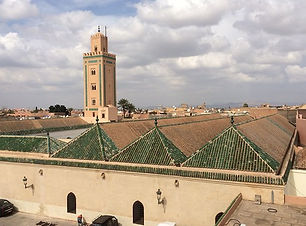I'm Abdellatif, your Marrakech Tour Guide
Certified tour guide with more than 30 years of experience.
A Journey through Marrakech Rich Cultural Heritage and Legacy
Marrakech The Red helps you to look into the soul of Morocco. Marrakech is the heart that beats an African, Berber, Jewish, Saharian identity into the complex soul of Morocco. Marrakech is probably the most exotic city in Morocco for the reason that it is the meeting point of cultures and continents. Marrakech is split into two different cities, the walled medina and Gueliz. Medina is of most interest to visitors its winding markets and historical monuments enclosed within pink walls of sun-baked mud. The Medina can be divided into quarters between north and south of the central square, the Jemaa El Fna. The square has always been at the center of medina life.
Book your Tour Now!

4 hr



4 hr
1- The Koutoubia Mosque
2- Bab Aguenaou
3- Kasbah Mosque
4-Saadian Tombs
5- Bahia Palace
6- Souks (Old Local Markets)
1-Dar El Bacha Museum
2- Le Jardn Secret
3-Medersa Ben Youssef
4- Koubba Al Moravide
5-Souks (Old Local Markets)
6-Jamae El Fna
1- Old Hammams (Moroccan Baths)
2-Old Fountains
3-Public Bakeries
4-A visit to craftsmen at their workshops
1- Majorelle Gardens
2- Palmeraie (Camel Ride)
3- Souks ( Local Markets)
Customize your Tour!
Create your own private adventure from a selection of unique itineraries that can be tailored to exactly what you like and how you want to see Marrakech

The Koutoubia Mosque
The tallest feature on the medina skyline is the Koutoubia Mosque (Mosque of the Bookseller). Built by Sultan Abdelmouman at the beginning of Almohad rule. It is the city’s most important landmark and serves as a useful point to relate the other sites in the city. The original Koutoubia Mosque was destroyed by the Almoravides’ successors the Almohads who descended from Tin Malin, the High Atlas and captured the city in 1147.
Excavations undertaken in 1948 have revealed the foundations of columns which would have supported the roof of the first Almohad mosque and it is still possible to see. It is the minaret that is the pride of the mosque today. The koutoubia minaret has been beautifully restored. The mosque tower served as the model for tour Hassan in Rabat and the Giralda in Seville. The minaret is nearly 70 meters (230 ft) high.

El Badi Palace
The palace was started in 1578, five months after the battle of the three kings put enormous wealth from Portuguese ransoms and captured … into the hands of Ahmed El Mansour the victorious. The palace took 25 years to complete and, at the hands of Moulay Ismail less than a century later, only 12 years to destroy. In Badi Palace, an 800 years old wooden minbar (pulpit) from the Koutoubia mosque has just been installed after a painstaking two-year restoration by New York metropolitan Museum of Art. The New York Times write that the minbar originally consisted of more than a million differently carved pieces of bone and colored woods, some pieces the size of sesame seeds. During the eight centuries it was rolled in and out of its closet in the mosque every Friday.

The Bahia Palace
The Bahia Palace (The brilliant) is a 19th century building that contains a series of paved courtyard, dark interior reception halls and Andalusian gardens, built by two generations of 19th century grand viziers Si Moussa (1859-73) and his son, Ba Ahmed. The architecture was highly traditional, a maze of passages, connecting doors, courtyard, gardens and pavilions, reception halls with their great paralleled Moorish ceilings of carved, painted and glided wood, the concubines courtyard. It’s impossible to not feel sympathy for the imprisoned women that once inhabited this glided cage, even though they themselves no doubt felt protected, pampered and privileged.

The Souks
(Market)
Flowing northwards from the Jemaa El Fna, on the opposite side from the palaces, are the souk of the medina. Explore the colorful souks (market place) of Marrakech. Each trade. Spices, carpets, jewelry, enamel, copper, brass, and cedar is situated in its unique quarter. You might see villagers bringing in their hand-tooling crafts as their ancestors used to do centuries ago.

The Mellah
Some hundred years after it occurred in most of the other cities of Morocco, The Jews of Marrakech were moved into a Mellah in 1558 on the orders of the Saadian Sultan Abdullah El Ghalib. The Sultan created a secure quarter for them beside the royal palace, protected by walls and entered through only two gates. They were a talented community of traders, metal smiths, bankers and linguists, a useful and valuable asset for the sultans. But within the mellah walls the community grew into one of the most populous and overcrowded in Morocco. Before 1936, there were 16000 Jews living here.

Dar El Bacha
Also in the northern part of the medina, is the Dar El Basha El Glaoui. This was formerly the palace of the Pasha Glaoui who collaborated with the French to rule Morocco. The glaoui, a berber clan from the region of Telouat, were the last of the old-stylle despotic rulers of Morocco. Built in 1910, the Dar El Bacha, which means ‘House of the Pasha’, was the residence of Thami El Glaoui, who was given the title of Pasha of Marrakech by the Sultan Moulay Youssef in 1912. Some important guests who visited Dar El Bacha include Colette, Maurice Ravel, Charlie Chaplin, Josephine Baker, and Winston Churchill among others. The palace was renovated by the Foundation Naionale des musées (FNM) of Morocco and converted into a museum known as Dar El Bacha. It was inaugurated by Mohamed VI, king of Morocco on 9 July 2017. Dar El Bacha represents a beautiful example of Moorish architecture , whith fountains and orange trees in the central court and traditional seating areas and a hammam.

The Saadian Tombs
The tombs are one of the most visited sites in Morocco, so in order to recapture some sense of serenity and isolation try to avoid the coach tours-visit either early in the morning or in the later afternoon. This is the ancient cemetery of the Shorfa, the descendants of the prophet, which had been in use for centuries before any Saadians arrived in Marrakech. The identity of most of the open-air mosaic graves is lost but a Merenid Sultan, Abou Hassan, was buried here in 1351, to be followed by the first Saadian Sultan, Mohamed ash-Sheikh, in 1557, in a tomb covered by simple Koubba. The existing koubbas were all built by Mohamed ash-Sheikh third ruling son, Ahmed El Mansour, in two stages. First, he built a pavilion around his father’s simple tomb, where he also buried his mother, Lalla Messaouda, in 1596. Later he built the hall of twelve columns to be his own mausoleum, and attached to it a prayer hall. The extraordinary interiors of Koubbas can be examined from their thresholds

The Ben Youssef Medersa
When the original 14thcentury, Merenid madrassa was rebuilt by Abdallah El Ghalib, the Saadian sultan made it the largest koranic school in Morocco in a deliberate attempt to snob the imams of Fez, the religious center of the country. The open sky is an integral part of Andalusian architecture. The spacious courtyard leads to a prayer hall whose proportions, balancing detailed carving and zellige decoration, gives an impression of serenity through a disciplined beauty.

The Kasbah Mosque
Passing through the gate you approach the Kasbah Mosque. It was finished in 1190 by Sultan Yaacoub el Mansour. The Merenids added a famous medersa to the Almohad mosque, but this was destroyed in a gun powder explosion in 1569. The Saadian Sultan Abdullah El Ghalib restored the damage mosque, which has been touched up every two hundred years, by Sidi Mohamed in the 18th century and recently by Hassan II. Beside the Mihrab, a door leads to the enclosed garden courtyard of the 16th royal necropolis- The Saadian Tombs

Dar Si Said
(Museum of Moroccan Arts and Crafts)
Wonder through the Dar Si Said Museum of traditional crafts. The collection of different crafts incudes many carpets of the best examples you will find in southern Morocco. Stylistically they are divided between Berber and Arab. The collection includes some beautiful pieces of local carved cedar-heavy dark doors, turned windows frames and screens, among them some 16 century Saadian work.

The Dar MNebhi
Marrakech
Museum
This opulent turn-of-the century palace has recently been converted into a museum owned by a charitable foundation, opened in 1997 and funded by the Omar Benjelloun Foundation. In the restored 19th century Dar Mnebhi Palace, the museum displays an electric collection of odds and ends. It does have some fine antique work of art but its real purpose is to build up a collection of contemporary Moroccan art to hold temporary exhibitions and other cultural events. It also has a pleasant café in the entrance courtyard.

The Ben Youssef Mosque
The Ben Youssef Mosque is more interesting for its history than for its building. It was first built by the Almoravid Sultan Ali Ben Youssef in the 12th century, as the central mosque of the medina. It was then as large as he present building. What you now see dates entirely from the early 19th century.

Maison Tiskiwin (Birt Flint Museum)
It houses another collection of Moroccan decorative art, put together by the Dutch anthropologist Birt Flint during three decades of field work in Morocco. The house ranged around a traditional Moorish courtyard, is itself reason enough for a visit. The exhibits offer an overview of the traditional material culture of Morocco. The highlight of the collection is the Zemmour room, with its dense collection of Middle Atlas weaving on floor and walls forming a bit of textile nomad. The vivid patterns on the leatherwork and you are meant to pass quickly through the private rooms which are equally intriguing.







